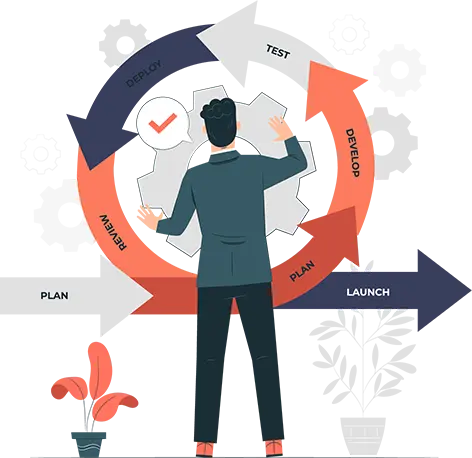
Software Development Costs
When it comes to custom software creation, VelanApps is up to the task. We've been working in this field for a long time. We offer premium services that are personalised for your business needs.

The cost of creating new software might vary widely. The cost depends on your specific requirements. The following are some of the factors that go into determining the total cost:
Complexity and novel numeric properties are two factors that affect costs. Preventable design flaws influence the final price tag.
Any available platform, including custom development and low-code environments, are all viable options. They have the potential to affect the total price. There are pros and cons to every option, and we at Velanapps will do our best to lay them all out for you.
The budget may be affected by the team's location, the duties they are given, and their level of experience. If your project needs experienced developers, it may be able to provide it more quickly but at a higher cost.
We can save expenses at Velanapps without sacrificing quality. We are going to present modular development. In this case, agile project management is combined with the reuse of preexisting components. This guarantees that the project stays within the allocated budget.
It's critical to comprehend the variables influencing project expenses.

The group will first perform a thorough needs analysis for your company. Recognize the software infrastructure and current procedures. Following this study, we will draft a feature roadmap for the product. We'll also simplify the design of the user experience (UX). Describing the manner in which our users will engage with the system is part of this.

We establish a well-organized framework for effective execution at this point. We employ a particular technology stack for this. This level is divided in two primary parts.

The server-side code and APIs are the focus of the backend developers. Interface mock-ups assist front-end developers in creating GUIs.

This procedure makes sure that both functional and non-functional needs are met by the program. Development and quality assurance (QA) happen simultaneously.

The program is being built at this level to be used. Installation, customisation, and user acceptability testing are among the things it involves. It entails creating user manuals and providing user education. The variance in the proportion is contingent upon the intricacy of the deployment prerequisites.

We install monitoring and analytics tools to track the performance of the software. It also helps in tracking user engagement and potential issues. This step is important in facilitating continuous enhancements.

After the software is live, ongoing maintenance is important. A dedicated support team or original developers can manage this. It includes resolving post-deployment bugs, accommodating evolving requirements and optimizing software and infrastructure. This ensures better performance, scalability, and cost-efficiency when addressing security vulnerabilities.
Application-Centric Aspects:
The nature of the application, be it for web, mobile, or desktop platforms.
The number of platforms and versions of operating systems required, especially concerning mobile app development.
The intricacy and number of features within the application
The extent to which different types of business needs are met by the software. That means HR, CRM, and the other business functions as well.
Comprehensive coverage of business procedures, including email marketing, lead nurturing, and advertising evaluation.
We focus on tailored solutions that resonate with precision through continuous deployment.
Software needs in terms of speed, reliability, safety, responsiveness, and scalability.
The total number of users and the functions they perform within the program
This needs a detailed understanding of the structure and layout of the programme. Layers, modules, and deployment options are all part of this.
Degree of integration with other software. This applies to both unilateral and bilateral applications of integration.
Machine learning with augmented/virtual reality implementation
Data migration is the process of moving information from obsolete legacy systems to a new software system.
Outlining the roles, experience levels and overall composition of the development team.
The finalized development strategy involves custom coding, low-code platforms or integrating pre-built products.
Outlining the method used to source development resources. This could be in-house, outsourced or a combination of both.
The geographic location of the outsourcing vendor, if outsourcing is part of the project strategy.

Software Development is a long and crucial process. Hence, onboarding the right partner is important. VelanApps has years of experience in software development.
We can support your company by offering tailored growth solutions. We have executed more than a thousand successful IT projects throughout the years.
Our track record of constantly meeting and exceeding client expectations is demonstrated by our portfolio.
We take great pride in our consistent ability to deliver on time, meet or exceed expectations, and provide solutions that help organizations in their growth.

We have executed more than a thousand successful IT projects throughout the years. Our track record of constantly meeting and exceeding client expectations is demonstrated by our portfolio. We take great pride in our consistent ability to deliver on time, meet or exceed expectations, and provide solutions that help organizations in their growth.

The professional team at VelanApps has years of expertise creating software for desktop, mobile, and web platforms. In terms of technology, we can accommodate a wide range of requirements. This ensures that a large number of users can use your software from a range of devices.

Personalization is one of our main focuses. We pay close attention to your initiatives. and make sure you get it right. Velan Apps values its client relationships. This helps us design software to meet their specific needs. Through this, the final product is effective and serves the purpose.

Our agile development ensures faster and more effective development cycles. At Velan Apps, we give importance to parameters like flexibility and quick adaptation. Through this, we ensure on reducing development restrictions which gives you adaptable solutions.
Have a unique request? Give us a call to get the assistance you require!
See our blog for the most recent information on industry news, tech developments, and professional
advice.
With our in-depth articles on a range of topics, be motivated and informed. Now go ahead and
read!
This is where our clients’ vision met our expertise. Explore some of the masterpieces we created for our clients:
The price tag for creating unique code varies widely amongst applications. There is no one price fits all. The pricing will vary depending on the number of features that are required.
Each project has its own unique requirements and level of complexity. How long it takes to create bespoke software depends on this. Longer feature lists, for instance, mean more time spent in development. A simple piece of software can be written in four to five months. However, it may take up to a year to complete the development of complicated software. A poor quality, non-sustainable final product is possible if the custom software development process is rushed.
Software development costing can be calculated using a number of methods, but generally speaking, they fall into two categories: ballpark and detailed. A ballpark estimate gives you an approximate sense of how much the app development will cost; a thorough estimate, on the other hand, is provided after the fact and is based on more precise calculations.
There are numerous ways to pay modern software development companies for their services. These are the best software development price models, along with explanations for a variety of scenarios.
Fixed PriceThis option works better for projects with set, well-defined needs. All development expenses are covered upfront. This software development price model has a lot to offer many clients, but it also carries a lot of dangers. There needs to be more connection with the workers, and it is easy to lose control. Furthermore, delays are a typical part of working on a large project.
Time and MaterialThe more flexible method is time and material pricing for software development. Payments for services are given gradually as opposed to all at once. You may be required to make payments every two weeks, once a month, or at any other desired period, contingent upon the conditions of the agreement. Thanks to this tactic, the team and the development process as a whole have more control.